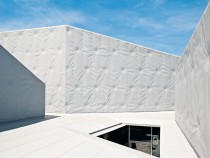
© Hervé Abbadie
Initially, the youth centre in Joué-lès-Tours on the south side of the French city of Tours dating to the 1950s was to be modernised, adapted to current requirements, and an addition was to be made to it. However, the preliminary studies quickly determined that an entirely new building would be the more economical alternative.
The design, which was the prize-winning entry to the architectural competition, proposed a reinterpretation of the existing building that uses the contours of its predecessor and retains from fragments of its load-bearing structure.
The result is a modern cultural centre that hosts sixty concerts per year and is to become a favourite meeting place. Known as “The Time Machine”, the building consists of a 2.5 metre high concrete base upon which a sculptural crown, cloaked entirely in a synthetic membrane, rests. The three main features of the building are legible in the volumes: a concert hall with a standing capacity for 650 concert-goers, a conference room seating 150, and a research centre. Rehearsal rooms in the basement and offices round off the program. The entrance area, which is completely glazed, opens up toward the forecourt and constitutes a flowing transition between interior and exterior. The cantilevering roof protects and “invites” both physically and gesturally.
The soft membrane employed in the facade contrasts strongly with the concrete walls. The outer skin consists of a 2 mm thick, multi-layer synthetic membrane with additional UV sunlight-protection agent and a glass-fibre inlay. Circular cuts with a diameter of 65 mm were made in the insulating layer around the respective points of connection of the synthetic membrane to the load-bearing concrete walls. The depressions that are brought about in this manner underscore the material’s flexibility and suppleness.
The design, which was the prize-winning entry to the architectural competition, proposed a reinterpretation of the existing building that uses the contours of its predecessor and retains from fragments of its load-bearing structure.
The result is a modern cultural centre that hosts sixty concerts per year and is to become a favourite meeting place. Known as “The Time Machine”, the building consists of a 2.5 metre high concrete base upon which a sculptural crown, cloaked entirely in a synthetic membrane, rests. The three main features of the building are legible in the volumes: a concert hall with a standing capacity for 650 concert-goers, a conference room seating 150, and a research centre. Rehearsal rooms in the basement and offices round off the program. The entrance area, which is completely glazed, opens up toward the forecourt and constitutes a flowing transition between interior and exterior. The cantilevering roof protects and “invites” both physically and gesturally.
The soft membrane employed in the facade contrasts strongly with the concrete walls. The outer skin consists of a 2 mm thick, multi-layer synthetic membrane with additional UV sunlight-protection agent and a glass-fibre inlay. Circular cuts with a diameter of 65 mm were made in the insulating layer around the respective points of connection of the synthetic membrane to the load-bearing concrete walls. The depressions that are brought about in this manner underscore the material’s flexibility and suppleness.



